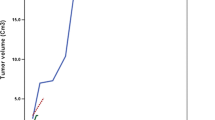Abstract
Background
Patients with vestibular schwannomas (VS) are either assigned to watchful waiting, microsurgical resection, or radiosurgery. Decision making on how to proceed is based on parameters such as age, tumor growth, loss of hearing, and the tumor’s Koos grading.
Methods
In order to correlate Koos grading with tumor volume, patient records of 235 patients with VS who underwent Gamma Knife radiosurgery (GKRS) were retrospectively reviewed.
Results
From 1994 to 2009, 235 consecutive patients underwent GKRS for sporadic VS at the Zurich Gamma Knife Center. Median follow up was 62.8 ± 33.0 months. Of the 235 tumors, 32 (13.6 %) were graded Koos I with a volume of 0.25 ± 0.3 cc; 71 (30.2 %) were graded Koos II with a volume of 0.57 ± 0.54 cc; 70 (29.8 %) were graded Koos III with a volume of 1.82 ± 1.88 cc; and 62 (26.4 %) were graded Koos IV with a volume of 4.17 ± 2.75 cc. Tumor progression was defined as a volume increase > 20 % at 2 years or later following GKRS. Overall tumor progression occurred in 21/235 (8.9 %) patients at 3.4 ± 0.9 years. Tumor progression did not differ statistically significantly in the various Koos grades: 1/32 (3.1 %) patients with VS Koos Grade I, 7/71 (9.8 %) patients with VS Koos Grade II, 6/70 (8.6 %) patients with VS Koos Grade III, and 7/62 (11.3 %) patients with VS Koos Grade IV.
Conclusion
To our knowledge, this is the first work correlating the various Koos grades of VS to their respective tumor volumes. In our patients, tumor volumes of VS Koos Grade IV were limited because all of our patients were eligible for radiosurgery. In our series, the outcome following GKRS for patients with VS Koos Grade IV tumors did not differ from patients with VS Koos Grades I–III. We therefore suggest to limit Koos Grade IV VS to tumor volumes < 6 cc that may be eligible for radiosurgery, and introduce an additional VS Grade V for large VS with tumor volumes of > 6 cc that may not be eligible for radiosurgery.



Similar content being viewed by others
References
Koos WT, Day JD, Matula C, Levy DI (1998) Neurotopographic considerations in the microsurgical treatment of small acoustic neurinomas. J Neurosurg 88:506–512
Schlegel I (2012) Gamma Knife Radiochirurgie von sporadischen unilateralen Vestibularisschwannomen. Inauguraldissertation Universität Basel, pp 30
Van de Langenberg R, Hanssens PEJ, Verheul JR, van Overbeeke JJ, Nelemans PJ, Dohmen AJC, de Bondt BJ, Stokroos RJ (2011) Management of large vestibular schwannoma. Part II. Primary Gamma Knife surgery: radiological and clinical aspects. J Neurosurg 115:885–893
Van de Langenberg R, Hanssens PEJ, Verheul JR, van Overbeeke JJ, Nelemans PJ, Dohmen AJC, de Bondt BJ, Stokroos RJ (2011) Vestibular schwannomas. Response to editorials. J Neurosurg 115:898–899
Conflicts of interest
None
Author information
Authors and Affiliations
Corresponding author
Additional information
Comment
The Authors address the issue of size and anatomical relationships of vestibular schwannomas as demonstrated in Koos grading, in the light of their radiosurgery practice. They show that Koos Grade IV is an inhomogenous group: one can have a high Koos Grade but small tumor, or a large one, usually associated with this grading. Considering the different size of the cerebellopontine angle in different individuals, this is not surprising, but has an obvious result of questioning the old mantra of recommending microsurgery for Koos Grade IV. In fact, one may find that the size of the cistern is a crucial factor, and an atrophied brain allows even large tumors to be treated with Gamma Knife safely (as indeed we find in the elderly, unfit for microsurgery).
The history of radiosurgery has been synonymous with a progressively increasing target size, as the quality of planning improved and good results emboldened practitioners to use the tool ever more boldly. It is reassuring to read the proof that up to 6 cc, this treatment for vestibular schwannomas is safe. The authors of this paper did not treat beyond this cut-off point. Anecdotally, according to a few published series, as well as according to the experience of this reviewer, one may push the boundaries even further when the surgical alternative is not applicable. Whether the outcome is comparable with microsurgery (the risks of which also rise with size) is up for future analysis. If one considers the segmental treatments and hypofractionation currently applied at other centres, there may be further radiosurgical avenues for those with even larger tumors.
Andras Kemeny,
Sheffield, UK
Rights and permissions
About this article
Cite this article
Mindermann, T., Schlegel, I. Grading of vestibular schwannomas and corresponding tumor volumes: ramifications for radiosurgery. Acta Neurochir 155, 71–74 (2013). https://doi.org/10.1007/s00701-012-1553-4
Received:
Accepted:
Published:
Issue Date:
DOI: https://doi.org/10.1007/s00701-012-1553-4




